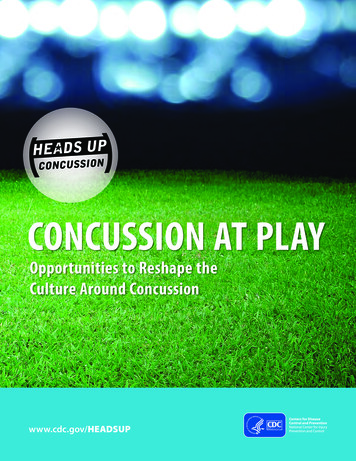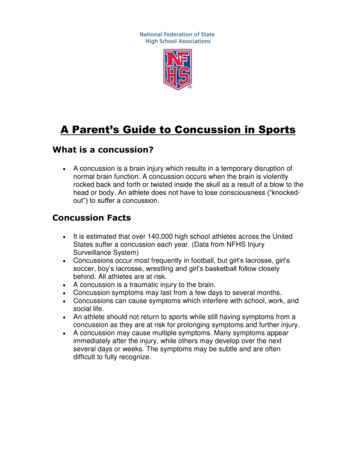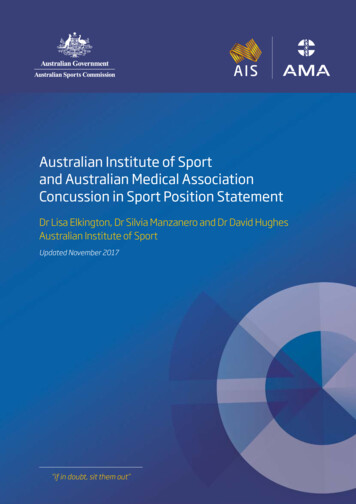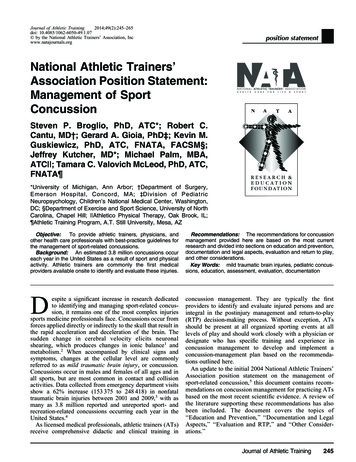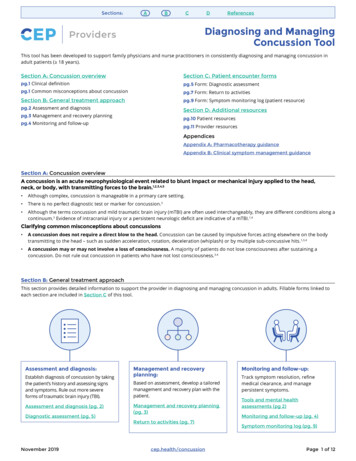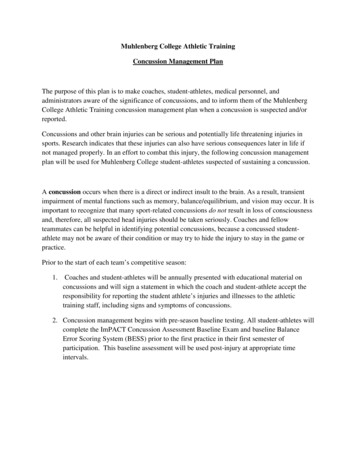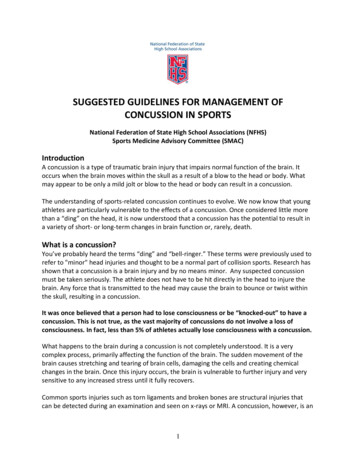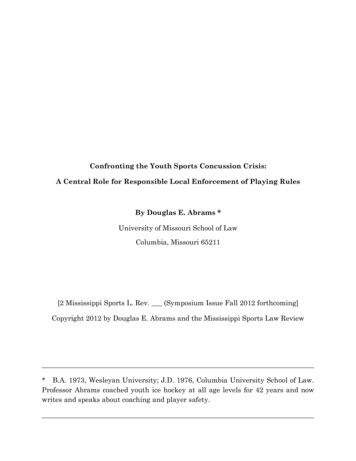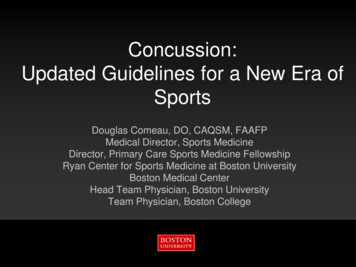
Transcription
Australian Institute of Sportand Australian Medical AssociationConcussion in Sport Position StatementDr Lisa Elkington and Dr David HughesAustralian Institute of SportMay 2016“if in doubt, sit them out”
Concussion Position StatementContents:1) EXECUTIVE SUMMARY12) AIS-AMA POSITION STATEMENT ON CONCUSSION IN SPORT2a.Introductionb.What is concussion?c.Recognising concussiond.Medical assessmente.Modifying factorsf.Managing concussiong.Children and adolescentsh.Long-term consequencesi.Concussion research prioritiesj.Key points for coaches, parents and athletesk.Key points for medical practitioners3) OVERVIEW OF ogyd.Assessment of suspected sport-related concussione.Evidence-based assessment toolsf.Managementg.Children and adolescentsh.Concussion modifiersi.Special considerations in concussionj.Education and prevention144) GUIDELINES IN AUSTRALIAN SPORTING CODES215) OTHER CONCUSSION RESOURCES226) CONCUSSION RESEARCH PRIORITIES237) REFERENCES24
1.EXECUTIVE SUMMARYThere has been growing concern in Australia and internationally about the incidence of sport-relatedconcussion and potential health ramifications for athletes. Concussion affects athletes at all levels of sportfrom the part-time recreational athlete to the full-time professional. If managed appropriately most symptomsand signs of concussion resolve spontaneously, however complications can occur including prolonged durationof symptoms and increased susceptibility to further injury. There is also growing concern about potentiallong-term consequences of multiple concussions. The Australian Institute of Sport (AIS) is Australia’speak high-performance sport agency. The Australian Medical Association (AMA) is the peak membershiporganisation representing the registered medical practitioners (doctors) and medical students of Australia.Both AIS and AMA have clear and unequivocal focus on ensuring the safety and welfare of Australiansparticipating in sport.Over recent years there has been elevated public awareness of sport-related concussion and increased focuson the importance of diagnosing and managing the condition promptly, safely and appropriately. There hasalso been concern over the possible long-term consequences of recurrent concussion.Sport administrators, medical practitioners, coaches, parents and athletes are seeking information regardingthe timely recognition and appropriate management of sport-related concussion. There is need for clear,unequivocal and reliable information to be readily accessible to all members of the community.Funded by the Australian Government, this AIS/AMA Position Statement on Concussion in Sport bringstogether the most contemporary evidence-based information and presents it in a format that is appropriatefor all stakeholders. The AIS and AMA seek to ensure that all members of the public have rapid access toinformation to increase their understanding of sport-related concussion and to assist in the delivery of bestpractice medical care.This Position Statement is intended to ensure that participant safety and welfare is paramount when dealingwith concussion in sport.1“if in doubt, sit them out”
2. AIS-AMA POSITION STATEMENTON CONCUSSION IN SPORTIntroductionSport-related concussion is a growing health concern in Australia. It affects athletes at all levels of sportfrom the part-time recreational athlete to the full-time professional. Concerns about the incidence, andpossible health ramifications for athletes, have led to an increased focus on the importance of diagnosingand managing the condition safely and appropriately3-6. Parents, coaches, athletes, medical practitioners andothers involved in sport are seeking information regarding the best management of sport-related concussion.Participant safety and welfare is paramount when dealing with all concussion incidents.The Australian Institute of Sport (AIS) is Australia’s peak high-performance sport agency. The AustralianMedical Association (AMA) is the peak membership organisation representing the registered medicalpractitioners (doctors) and medical students of Australia. Both AIS and AMA have clear and unequivocal focuson ensuring the safety and welfare of Australians participating in sport.Funded by the Australian Government, this position statement aims to: provide improved safety and health outcomes for all people who suffer concussive injuries whileparticipating in sport assist all sporting organisations and clubs to align their policy and procedures to the most up-to-date evidence protect the integrity of sport through the consistent application of best practice protocols and guidelines provide a platform to support the development of national policy for the management of concussion in Australia.What is concussion?Concussion is a type of brain injury, induced by a force to the head or anywhere on the body, which transmitsan impulsive force to the head. It commonly causes short-lived neurological impairment and the symptomsmay evolve over the hours or days following the injury. The symptoms should resolve without medicalintervention. Rest, followed by gradual return to activity, is the main treatment2. Evidence from animal andfunctional imaging studies points toward a series of interrelated biochemical and physiological changes thatimpair neuronal function7-15.Recognising concussionRecognising concussion can be difficult. The symptoms and signs are variable, non-specific and may be subtle.Onlookers should suspect concussion when an injury results in a knock to the head or body that transmits aforce to the head. A hard knock is not required, concussion can occur from relatively minor knocks.There may be obvious signs of concussion such as loss of consciousness, brief convulsions or difficultybalancing or walking. However, the signs of concussion can be more subtle. The Sport Concussion AssessmentTool (SCAT 3) identifies 22 possible symptoms1,16,18: headache dizziness sensitivity to noise ‘don’t feel right’ confusion irritability ‘pressure in the head’ blurred vision feeling slowed down difficulty concentrating drowsiness sadness neck pain balance problems feeling like ‘in a fog’ difficulty remembering trouble falling asleep nervous or anxious nausea or vomiting sensitivity to light fatigue or low energy more emotional“if in doubt, sit them out”2
Recognising concussion is critical to correct management and prevention of further injury. The PocketConcussion Recognition Tool, developed by the Concussion in Sport Group to help those without medicaltraining detect concussion, includes a list of these symptoms1.When an athlete is suspected of having a concussion, first-aid principles still apply, and a systematic approachto assessment of airway, breathing, circulation, disability and exposure applies in all situations. Cervical spineinjuries should be suspected if there is any loss of consciousness, neck pain or a mechanism that could leadto spinal injury. Manual inline stabilisation should be undertaken and a hard collar applied until a cervical spineinjury can be ruled out.A medical doctor should review any athlete with suspected concussion. In a situation where there is no accessto a medical practitioner, the athlete must not be returned to sport on the same day. If there is any doubtabout whether an athlete is concussed that athlete should not be allowed to return to sport that day. Anathlete with suspected concussion should be reassessed to look for developing symptoms and cleared by amedical practitioner before returning to sport. Due to the evolving nature of concussion, any athlete cleared toreturn to sport after being assessed for suspected concussion should be monitored closely during the game/competition for developing symptoms or signs.Sometimes there will be clear signs that an athlete has sustained a concussion. Medical practitioners coveringsporting events should immediately remove an athlete with any of the following clinical features: loss of consciousness no protective action in fall to ground directly observed or on video impact seizure or tonic posturing confusion, disorientation memory impairment18 balance disturbance (e.g. ataxia) athlete reports significant, new or progressive concussion symptoms dazed, blank/vacant stare or not their normal selves behaviour change atypical of the athlete.Athletes displaying these signs should be treated as concussed and not be returned to sport.Some features suggest more serious injury and athletes displaying any of these signs should be immediatelyreferred to the nearest emergency department: neck pain increasing confusion or irritability repeated vomiting seizure or convulsion weakness or tingling/burning in the arms or legs deteriorating conscious state severe or increasing headache unusual behavioural change double vision.3“if in doubt, sit them out”
Medical assessment of concussionThe diagnosis of concussion should be made by a medical practitioner after a clinical history and examinationthat includes a range of domains including mechanism of injury, symptoms and signs, cognitive functioningand neurological assessment including balance testing16,18. The SCAT 3 is the internationally recommendedconcussion assessment tool and covers the above mentioned domains1. This should not be used in isolationbut as part of the overall clinical assessment. Computerised neurocognitive testing can be undertaken as partof the assessment but again, should not be used in isolation. Baseline neurocognitive testing can be useful inthe pre-season period for comparison with post-injury scores. Many programs however have reference rangesthat can be applied in the absence of a baseline test.There are currently no serum biomarkers that assist in the diagnosis of concussion. Blood tests are notindicated for uncomplicated concussion. Medical imaging is not indicated in the diagnosis or management ofuncomplicated concussion. Medical imaging may be indicated however where there is suspicion of more serioushead or brain injury1.Where resources allow, sporting organisations should optimise the use of modern technology such aspitch-side instant video replay, to enhance the ability to detect and manage concussion.Modifying factorsWhile the medical practitioner assessing the athlete with suspected concussion should make optimaluse of available assessment tools, clinical judgement remains a cornerstone of concussion diagnosis andmanagement. Concussion modifiers are factors that may impact upon the clinician’s management of theconcussed athlete1. Such modifiers can be associated with a more protracted recovery time28,29,30,32.Concussion modifiers include the following: a high number of concussive symptoms high severity of concussive symptoms prolonged loss of consciousness (greater than one minute) post-concussive seizure previous history of concussion age of the athlete history of depression, anxiety, migraine, learning disability, ADHD or sleep disturbance use of medications, especially psychoactive or anticoagulant medication.Managing concussionHead-injury advice should be given to all athletes with concussion, and to their carers. Any athlete withsuspected or confirmed concussion should remain in the company of a responsible adult and not be allowed todrive. They should be advised to avoid alcohol and check medications with their doctor. Specifically, they shouldavoid aspirin, anti-inflammatories, sleeping tablets and sedating pain medications.“if in doubt, sit them out”4
Once the diagnosis of concussion has been made immediate management is physical and cognitive rest19,20.This may include time off school or work and rest from all cognitive activity. The majority of concussivesymptoms should resolve in 7-10 days. After a minimum of 24 hours without any symptoms, the patient cancommence a return to cognitive and physical activity1,21. The activity phase should proceed as outlined belowwith a minimum of 24 hours spent at each level. The activity should only be upgraded if there has been norecurrence of symptoms during that time. If there is a recurrence of symptoms, there should be a ‘step down’ tothe previous level for at least 24 hours (after symptoms have resolved)1. The steps in the activity phase are: begin with light aerobic activity basic sport-specific drills which are non-contact and with no head impact more complex sport-specific drills without contact. May add resistance training. full contact practice following medical review normal competitive sporting activity.Sporting organisations need to continually review their policies for best practice concussion diagnosis andmanagement. High-risk sports such as professional collision sports need to ensure that medical personnel areappropriately trained in the detection and management of concussion. The potential benefits of rule changessuch as introduction of independent concussion doctors require careful consideration against possibleunintended negative consequences. Those who know the athlete may be best equipped to detect some ofthe subtle signs of concussion. Removing the team doctor entirely from the assessment and decision-makingcould conceivably compromise the ability to detect subtle concussions. A compromise could be a model thatallows team doctors to assess concussions, with independent doctors to oversee the process and sign off onany athletes being returned to the field.See diagram 1 on page 8.Children and adolescentsChildren and adolescents aged 18 and under may be more susceptible to concussion and take longer to recover,requiring a more conservative approach to concussion22-25,31. Return to learn should take priority over return tosport. School programs may need to be modified to include more regular breaks, rests and increased time tocomplete tasks. The symptom-free rest period should be extended in this group. The graduated return to sportprotocol should be extended such that the child does not return to contact training, sport or play less than 14days from the resolution of all symptoms.See diagram 2 on page 9.Long-term consequencesThere is concern about potential long-term consequences of concussion33,34. There is currently no reliableevidence clearly linking sport-related concussion with chronic traumatic encephalopathy (CTE)17,35-38.The evidence purporting to show a link between sport-related concussion and CTE consists of case reports,case series and retrospective analyses. Due to the nature of the studies, and the reliance on retired athletesvolunteering for an autopsy diagnosis, there is significant selection bias in many of the reported cases. Thestudies to date have not adequately controlled for the potential contribution of confounding variables such asalcohol abuse, drug abuse, genetic predisposition and psychiatric illness17,39,40.Given that concussion is very common and the number of cases of CTE reported is extremely small, the linkbetween sport-related concussion and CTE remains tenuous. The potential link between concussion and CTEis of concern however and there is need for well-designed prospective epidemiological studies, which take intoaccount the potential confounding variables.EducationA number of studies have demonstrated that general knowledge about concussion is inadequate. Educationprogrammes must target the various groups involved in sport-related concussion in order to effectivelyimprove awareness and understanding in the community. Athletes themselves need to have a good5“if in doubt, sit them out”
understanding of concussion in order to appreciate the importance of reporting symptoms and complying withrest and return to sport advice. Parents and coaches must also be able to recognise the symptoms and signs ofconcussion in order to detect concussions at the community sport level where there is no medical supervisionpresent 41-47. Sporting and medical organisations continue to develop specific recommendations aroundconcussion in order to educate their own participants46, 48, 49.Concussion research prioritiesThere is a clear need for well-designed prospective research to inform the diagnosis and management ofconcussion. Areas that require priority in terms of resource allocation include the biological processes underlyingconcussion, the impact of concussion on long-term health, the role of concussion in special groups such aschildren and the effectiveness or otherwise of concussion education programs. There also needs to be ongoingresearch to constantly update and improve clinical tools used in the diagnosis and management of concussion.Key Points for coaches, parents and athletes Concussion is a type of brain injury that occurs from a knock to head or body. Recognising concussion is critical to correctly managing and preventing further injury. The Pocket Concussion Recognition Tool is recommended to help recognise the signs and symptoms ofconcussion. This can be freely downloaded at bjsm.bmj.com/content/47/5/267.full.pdf First-aid principles apply in the management of the athlete with suspected concussion. This includesobserving first-aid principles for protection of the cervical spine. Any athlete suspected of having concussion should be removed from sport and not allowed to return tosport that day. This athlete should be reviewed by a medical doctor. Features that suggest more serious injury and should prompt immediate emergency department referralinclude neck pain, increased confusion or irritability, repeated vomiting, seizure, weakness or tingling/burningin the arms or legs, reduced level of consciousness, severe or increasing headache, or unusual behaviour. When assessing a patient with suspected concussion, a medical doctor will ask about details of the eventas well as past medical history and then assess the patient including asking about symptoms, signs, testingmemory function and concentration, balance and neurologic function. There is no single test that can determine whether someone has sustained a concussion, your doctor maynot order blood tests or medical imaging unless they wish to exclude other more serious injuries. Once a diagnosis of concussion has been confirmed the main treatment for concussion is rest. When symptomshave resolved for a minimum of 24 hours (longer for children) gradual return to sport can usually begin. The activity phase should proceed as outlined below with a minimum of 24 hours spent at each level. Theactivity should only be upgraded if there has been no recurrence of symptoms during that time. If this occursthere should be a ‘step down’ to the previous level for at least 24 hours (after symptoms have resolved):-begin with light aerobic activity-basic sport-specific drills which are non-contact and with no head impact-more complex sport-specific drills without contact, may add resistance training-full contact practice following medical review-normal competitive sporting activity. Children and adolescents take longer to recover from concussion. They should have a longer rest period(48 hours) and recommended minimum of 14 days from when symptoms cease before returning to fullcontact sport (after medical clearance). The long-term consequences of concussion and especially multiple concussions are not yet clearly understood. If in doubt, sit them out.See diagrams 3 and 4 for non-medical assessment of concussion (on and off field) on pages 10–11.“if in doubt, sit them out”6
Key Points for medical practitioners Concussion can be very difficult to detect. The symptoms and signs can be varied, non-specific and subtle. Athletes with suspected concussion should be removed from sport and assessed by a medical doctor. When assessing acute concussions, a standard primary survey and cervical spine precautions should be used. The diagnosis of concussion should be based on a clinical history and examination that includes a range ofdomains including mechanism of injury, symptoms and signs, cognitive functioning, neurology includingbalance assessment. The SCAT 3 is the internationally recommended concussion assessment tool and covers theabovementioned domains. It can be freely downloaded at bjsm.bmj.com/content/47/5/259.full.pdf.This should not be used in isolation but as part of the overall clinical assessment. Computerised neurocognitive testing can be undertaken as part of the assessment but should not be usedin isolation. Children and adolescents may be more susceptible to concussion and take longer to recover. A moreconservative approach should be taken with those aged 18 years or younger and the symptom-free restperiod should be extended in this group. The graduated return to sport protocol should be extended suchthat the child does not return to contact training, sport or play in less than 14 days. Blood tests are not indicated for uncomplicated concussion. Medical imaging is not indicated unless there issuspicion of more serious head or brain injury. Standard head-injury advice should be given to all athletes suffering concussion and to their carer. Once the diagnosis of concussion has been made, immediate management is physical and cognitive rest. Thisincludes time off school or work and rest from all cognitive activity. The majority of concussive symptomsshould resolve in 7-10 days. After a minimum of 24 hours without any symptoms the patient can commencea return to cognitive and physical activity. Some sports have their own guidelines or recommendations around the management of concussion insport which should also be considered. If in doubt, sit them out.There is currently no strong evidence clearly linking sport-related concussion with chronic traumaticencephalopathy (CTE). The evidence purporting to show a link between sport-related concussion and CTEconsists of case reports, case series and retrospective analyses. Due to the nature of the condition and thereliance on retired athletes nominating to posthumously undergo autopsy as part of this research thereis significant bias in the samples examined and confounding factors such as alcohol abuse, drug abuse,genetic predisposition and psychiatric illness have not been controlled for adequately. Further well designedprospective studies are needed to better understand the possible relationship.See diagrams 5 and 6 for medical assessment of concussion (on and off field) on pages 12–13.7“if in doubt, sit them out”
Diagram 1: Return to Sport Protocol for adults over 18 years of ageDiagnosis of concussionNo return to sportComplete physical and cognitive restMust be symptom free for at least 24 hoursLight aerobic activity (24 hours)Recurrence of concussion symptomsBasic sport-specific drills whichare non-contact – no headimpact (24 hours)Recurrence of concussion symptomsMore complex sport-specific drillswhich are non-contact – no headimpact – may add resistance training(24 hours)Recurrence of concussion symptomsMedical review before returnto full contact trainingIf not medically cleared, any furtheractivity to be determined bymedical practitionerReturn to full contacttraining (24 hours)Return to sportRecurrence of concussion symptomsCOMPLETE FORMAL MEDICAL REVIEWRecurrence of concussion symptomsCOMPLETE FORMAL MEDICAL REVIEW“if in doubt, sit them out”8
Diagram 2: Return to Sport Protocol for children under 18 years of ageDiagnosis of concussionNo return to sportComplete physical and cognitive restMust be symptom free for at least 48 hours9Return to learn: no return to physicalactivity until after successful return toschool and other cognitive activitiesRecurrence of concussion symptomsLight aerobic activity (24 hours)Recurrence of concussion symptomsBasic sport-specific drills whichare non-contact – no headimpact (24 hours)Recurrence of concussion symptomsMore complex sport-specific drills whichare non-contact – no head impact – mayadd resistance training (24 hours)Recurrence of concussion symptomsNo return to contactactivities before 14 days from completeresolution of all concussion symptomsRecurrence of concussion symptomsMedical review before returnto full contact trainingIf not medically cleared, any furtheractivity to be determined bymedical practitionerRecurrence of concussion symptomsReturn to full contact training(24 hours)COMPLETE FORMAL MEDICAL REVIEWReturn to sportRecurrence of concussion symptoms“if in doubt, sit them out”COMPLETE FORMAL MEDICAL REVIEW
Diagram 3: Non-medical assessment of concussion – on field(for parents, coaches, teachers, team-mates)Athlete withsuspected concussionOn-field signs of concussion: Loss of consciousness Lying motionless, slow to get up Seizure Confusion, disorientation Memory impairment Balance disturbance Nausea or vomiting Headache or ‘pressure in the head’ Visual or hearing disturbance Dazed, blank/vacant stare Behaviour or emotional changes, not themselvesThings tolook out forat the timeof injuryImmediate and permanent removal from sportTake normal first-aid precautions including neck protectionRED FLAGS Neck pain Increasing confusion or irritability Repeated vomiting Seizure or convulsion Weakness or tingling/burning in the arms or legs Deteriorating conscious state Severe or increasing headache Unusual behavioural change Visual or hearing disturbanceNOYESRefer to medicalpractitioner assoon as practicalImmediatereferral toemergencydepartment“if in doubt, sit them out”10
Diagram 4: Non-medical assessment of concussion – off field(for parents, coaches, teachers, team-mates)Athlete withsuspected concussionSubtle signs of concussion: Pale Difficulty concentrating Fatigue Sensitivity to light/noise Confusion, disorientation Memory impairment Nausea Headache or ‘pressure in the head’ Feeling slowed or ‘not right’ Dazed, blank/vacant stare Behaviour or emotional changes, not themselvesReview bymedical practitionerRED FLAGS Neck pain Increasing confusion or irritability Repeated vomiting Seizure or convulsion Weakness or tingling/burning in the arms or legs Deteriorating conscious state Severe or increasing headache Unusual behavioural change Visual or hearing disturbance11NOYESRest, observation,return to sportprotocol undermedical adviceImmediatereferral toemergencydepartment“if in doubt, sit them out”Things to lookout for at homeor at schoolfollowinga possibleconcussion
Diagram 5: Medical assessment of concussion – on fieldAthlete withsuspected concussionSigns of concussion: Loss of consciousness Seizure or tonic posturing Confusion, disorientation Memory impairment Balance disturbance Dazed, blank/vacant stare Behaviour change, not themselvesYESNOAthlete concussedImmediate and permanentremoval from playRemove for sidelineconcussion assessmentEvidence of structuralintracranial pathologyor spinal injurySCAT 3Neurological examinationUse of video assessment ifavailable (professional sport)YESNOEvidence of concussionSCAT 3Neurological examinationMonitor and reassessas appropriateSigns of neurologicaldeterioration: Worsening headache Emotionally labile Altered level ofconsciousness Vomiting Focal neurological signsPermanent removalfrom playNo evidence of concussion Athlete may bereturned to play butmust be closelymonitored forevolving signs ofconcussion or moreserious head injury Reassess at halftime/full time If any signsof concussiondevelop, the athletemust be permanentlyremoved from playImmediate referralto emergencydepartment“if in doubt, sit them out”12
Diagram 6: Medical assessment of concussion – off field(for emergency departments and medical clinics)Athlete withsuspected concussionHistory suggesting concussion: Trauma Loss of consciousness Seizure Headache Drowsiness Nausea/vomiting Balance disturbance Confusion, memory impairment Emotionally labile Visual disturbanceYESNOSCAT 3Neurological examinationSCAT 3Neurological examinationNormalMonitor andreassess asappropriateInstigate return tosport protocol, oncesymptom freeClear instructionto stop sport andreturn for furtherassessment, ifany symptomssubsequently develop13“if in doubt, sit them out”AbnormalNo suspicionof intracranialpathology orspinal injuryNormalMedicalinvestigations ifany suspicion ofintracranial pathologyor spinal injuryInvestigations normalInstigate return tosport protocolClear instructionto stop sport andreturn for furtherassessment, ifany symptomssubsequently developInvestigations abnormalSpecialist referral
3. OVERVIEW OF LITERATUREDefinitionConcussion is a type of brain injury. It is recognised as a complex injury that is a challenge to evaluate andmanage. The Concussion in Sport Group (CISG) has hosted four International Consensus Conferences since2001. Each consensus conference has published a statement summarising the findings of the group.Consensus statement recommendations from the most recent conference in Zurich in 2012 have guidedclinicians and others managing sport-related concussion since that time1. As defined by the internationalconsensus statement, concussion is ‘a complex pathophysiological process affecting the brain, induced bybiomechanical forces’. It generally results from a knock – often to the head, face or neck but may be anywherein the body – which transmits an impulsive force to the head. Concussion commonly involves short-livedimpairment of neurological function. Concussion is an evolving injury that may change over the first few hoursand sometimes over a few days. In most cases symptoms have resolved seven days post injury2.The International Consensus Group considers concussion to be a subset of mild traumatic brain injury1.As discussed below, epidemiological data, particularly hospital data, does not distinguish between traumaticbrain injury and mild traumatic brain injury or concussion.EpidemiologySport-related concussion is a public health concern in Australia. Precise data on the incidence of sport-relatedconcussion in Australia is lacking. Potential limitations to obtaining accu
The Australian Institute of Sport (AIS) is Australia's peak high-performance sport agency. The Australian Medical Association (AMA) is the peak membership organisation representing the registered medical . Concussion modiiers are factors that may impact upon the clinician's management of the concussed athlete. 1. Such modiiers can be .
